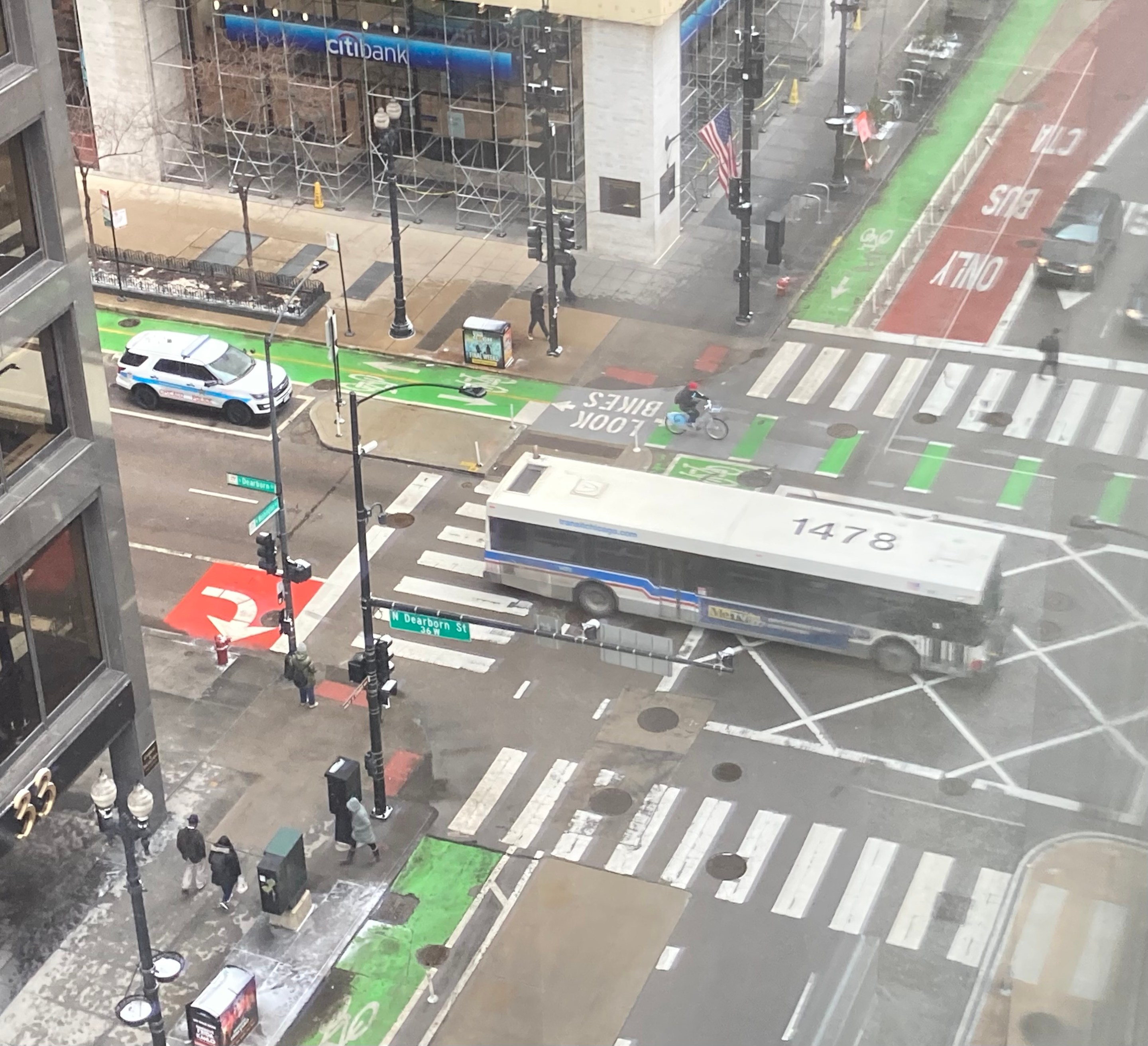The 47th Ward – which includes parts of North Center, Lincoln Square and Ravenswood – saw more than it's fair share of high-profile traffic violence in 2022, including the tragic deaths last summer of toddler Rafi Cardenas, 2, and ward volunteer Peter Paquette, 75. Local alderperson Matt Mart responded in part by bringing the Chicago and Illinois transportation departments to the negotiating table, resulting in an agreement that gives the city more freedom to make pedestrian safety improvements at the intersections of city- and state-jurisdiction roads, announced in January.

Martin's current campaign for safer streets includes the Complete Streets ordinance he introduced last July, with the goal of ensuring that every time the Chicago Department of Transportation repaves a street, or does a streetscape project, rather than simply restriping it the same car-oriented manner as before, the project prioritizes safe and efficient sustainable transportation.
At this Friday's meeting of the City Council's Committee on Pedestrian and Traffic Safety, 11 a.m. at City Hall. the ordinance will likely be presented for a preliminary vote. If the measure passes, the full Council will probably take a final vote at its next meeting on Wednesday, March 15.
"After a lot of exchanges with the department of transportation, we have settled on a revised ordinance that has CDOT's support and, we believe, a chance of passing City Council," wrote 47th ward director of development and infrastructure Josh Mark in an email to constituents earlier this week. See the full text of the revised measure at the bottom of this post.
Mark called on supporters to call their alderperson (find yours here) to express support, particularly if the alder is a member of the committee. And if the ordinance passes, it would be a good idea to follow up before the full vote next Wednesday.
The ordinance would mandate that CDOT draft design guidelines standardizing the installation of safety infrastructure in road projects. It also calls for the department to create and maintain a toolbox of safe streets elements – such as wheelchair ramps, raised crosswalks, pedestrian islands, curb extensions, bus boarding islands, bus lanes, and protected bike lanes – along with criteria for their use. The department would also be required to report to the Council the type and location of all safety improvements, along with any updates to the guidelines and toolbox.
Mark noted in his email that Chicago needs to address the pandemic era spike in traffic fatalities, particularly pedestrian and bike deaths, by increasing the rate at which safety updates are installed. He also noted that bus infrastructure will shorten trips for transit riders.
Mark told Streetsblog that CDOT has endorsed the measure, as have several alderpersons have voiced support for the legislation, including sustainable transportation-friendly alders Daniel La Spata (1st), Rossana Rodriguez-Sanchez (33rd), and Andre Vasquez (40th.) He also credited advocacy groups like the Active Transportation Alliance and Commuters Take Action for urging residents to talk to their representatives about the measure.
Out of all 50 wards, ward 47 @AldMattMartin spent the most on ‘Traffic Calming’. He also came in 2nd place for most menu money allocated to bike lanes 💚 https://t.co/TDltL4tS3K pic.twitter.com/cDzwmtr6V6
— Bike Lane Uprising® (@bikelaneuprise) February 6, 2023
Mark added that the legislation "is not just about keeping with what's happening in cities in other countries, but also U.S. cities like Madison, Wisconsin, that have learned to layer walking, biking, and transit improvements into existing upcoming projects. As important as this ordinance is, we see it as a baseline as we try to ramp up the standard for pedestrian and bike safety in the future."
Ald. La Spata told Streetsblog, "I’m glad to see Complete Streets become the guiding ethos for transportation projects in the city, rather than feeling like an afterthought. It ensures our capital investments recognize the needs of all users of the public way."
Text of the revised ordinance
BE IT ORDAINED BY THE CITY COUNCIL OF THE CITY OF CHICAGO:
SECTION 1. Title 10 of the Municipal Code of the City of Chicago is hereby amended by
inserting new Chapter 10-14, as follows:
CHAPTER 10-14 COMPLETE STREETS
10-14-010 Transportation planning requirements.
(a) Vehicular, public transportation, bicycle, and pedestrian modes of travel are integral to
the transportation system. The Department of Transportation shall view all transportation improvements as opportunities to improve safety, access, and mobility for all travelers especially people who have experienced systemic underinvestment or whose needs have not been met through past transportation planning processes.
(b) Accommodations for all users shall be included in the planning, design, construction, reconstruction, rehabilitation, maintenance, and operations of any transportation facility under the jurisdiction of the Department. The Department shall aim to create a safe, comprehensive, integrated, and connected network to accommodate all users in a manner that is suitable to the context of the area.
(c) The Department shall incorporate federally and regionally recognized best practice complete street elements in the design and construction of city transportation projects, improvements and facilities.
(d) The Commissioner of Transportation shall establish, by rule, complete streets design guidelines for the construction of major transportation projects. The complete streets design guidelines shall identify a toolbox of safety-enhancing street design elements for all modes and establish criteria or a process the Department will use to evaluate the applicability and suitability of various elements. The complete streets design guidelines shall also identify a list of standard safety-enhancing street design elements for major transportation programs, including but not limited to arterial resurfacing, streetscapes and roadway reconstruction, that the Department will aim to integrate as standard practice for projects in these programs. Safety-enhancing street design elements in the complete streets design guidelines shall include, but need not be limited to, the following elements:
(i) ADA accessible curb ramps;
(ii) context sensitive travel lane widths;
(iii) measures to reduce pedestrian crossing distance such as curb extensions and safety islands;
(iv) new and enhanced pedestrian crossings;
(v) corner clearance and visibility improvements; and
(vi) raised crosswalks and speed tables;.
(vii) protected bicycle lanes; and
(viii) dedicated mass transit facilities such as bus lanes and bus bulbs.
The Department may amend the toolbox of safety-enhancing design elements by rule to promote safety for all roadway users.
(e) At least once a year, the Department shall report to the City Council Committee on Pedestrian and Traffic Safety, or its successor committee, any updates to the toolbox of safety enhancing design elements required by Section 10-14-010(d) and a list of the Department’s major projects. The report shall list the reasons behind any changes to the toolbox and the type, location and quantity of safety-enhancing street design elements programmed or implemented by the Department through these major projects.
(f) This Section applies to transportation projects for which a preliminary design starts on or after December 31, 2023.
Matthew J. Martin Alderman, 47th Ward

Did you appreciate this article? Please consider making a tax-deductible donation to help fund Streetsblog Chicago's next year of publication. Thanks!



